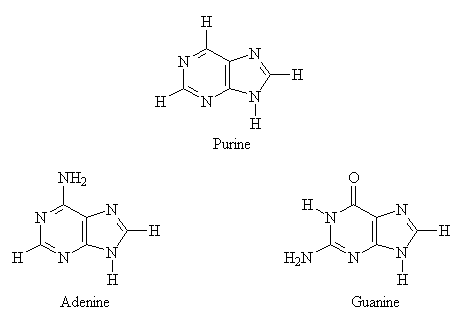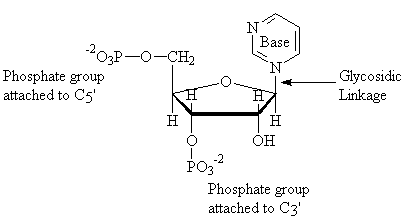
Nucleic Acids and Nucleotides
Contents
- Nucleic Acid Bases
- Hydrogen-Bonding Sites in Nucleic Acid Bases
- Hydrogen-Bonded Nucleic Acid Base Pairs
- Sugars present in DNA and RNA
Nucleic Acid Bases
DNA and RNA contain bases derived from pyrimidine (a nitrogen-base containing a single aromatic ring) and purine (a nitrogen-base containing two fused aromatic rings). The structures of both the parent bases and the derivatives commonly found in nucleic acids are shown below.


Hydrogen-Bonding Sites in Nucleic Acid Bases
One of the most important structural features of polynucleotides is the fact that they are able to participate in H-bonding. The diagram below indicates the H-bond donor and H-bond acceptor sites for the common nucleic acid bases.


- (A)
- H-bond acceptor. Requires a lone pair of electrons on an electronegative atom, such as F, O, or N.
- (D)
- H-bond donor. Requires a H atom covalently bonded to an electronegative atom. For example, H-F or H-O. While there is currently debate in the scientific literature about whether H-N bonds can form "true" hydrogen bonds, these type of interactions are very important in DNA and RNA and will be considered H-bonds in this course.
Hydrogen-Bonded Nucleic Acid Base Pairs
Steric/spatial requirements in DNA require that a single pyrimidine interacts with a single purine base. Two pyrimidine bases are too small, and cannot get close enough together to form H-bonds. Conversely, two purine bases are too large to fit into the gap separating the two strands of DNA.

The above diagram illustrates the Hydrogen-bonding pairs found in DNA. Note that the A-T pair has only two H-bonds because of the adenine molecule. (The lone pair of electrons on the oxygen atom in thymine molecule could act to form a third H-bond, but adenine does not have the required donor). The arrangement of donors and acceptors in thymine and guanine precludes formation of H-bonding pairs between these two compounds.
Sugars present in DNA and RNA

Ribose and deoxyribose are the sugars found in RNA and DNA, respectively. The only difference in structure between these two molecules occurs at C2.

Shown above is a nucleotide, which consists of a base, a sugar, and a phosphate group, with a second phosphate group attached to C3. Shown below is a poly-nucleotide, linked by a phosphodiester bond.

Last modified February 25, 1997
Kent State University - Stark Campus
Department of Chemistry
This Page Written and Maintained by Dr. Clarke Earley
